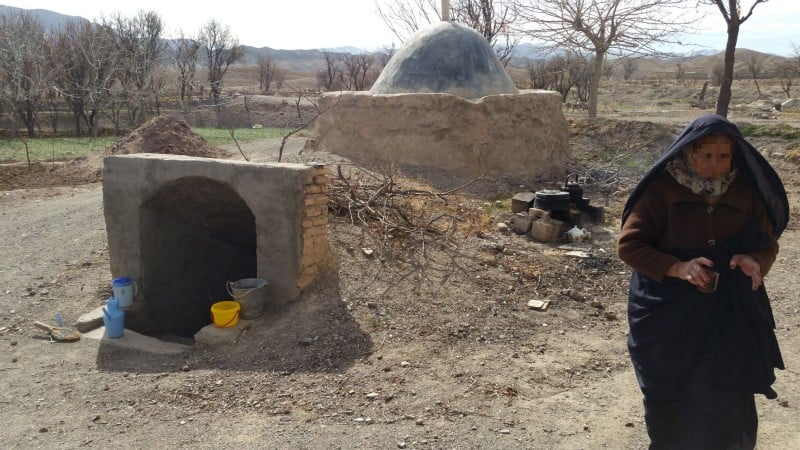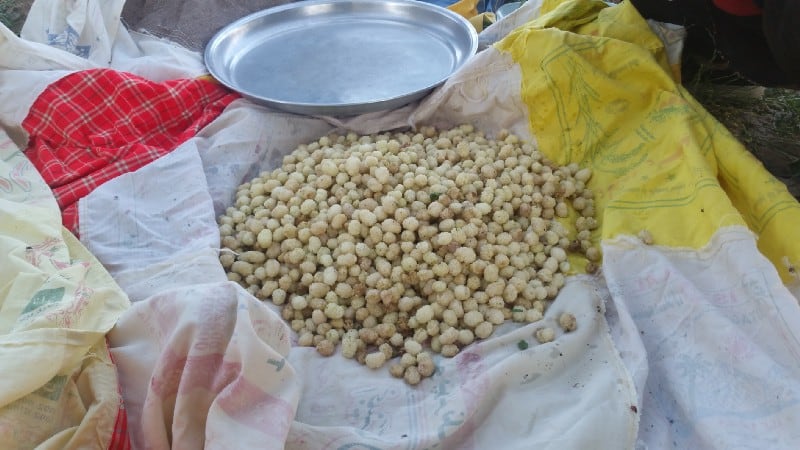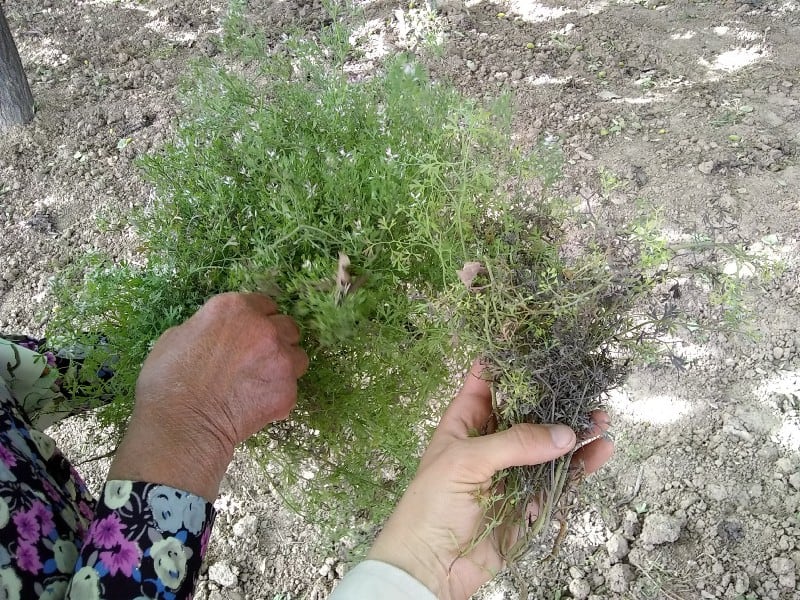Learning a new way of living from an elder Iranian farmer
By Kali Morgan

Of late, I have been consumed by the stories of strong, bold, warrior-spirited women of long ago, like Queen Tomyris of the Massagetae of Central Asia (who may or may not have killed Cyrus) and the more well-known Judith of ancient Israel (who decapitated Holofernes). Imagery such as the statue pictured above, in which the mother-protector holds a bowl of wine in one hand and a sword in the other, are powerful symbols. These women, in their passionate fight against injustice and oppression, have influenced me as I consider how I can fight against evil and the oppressive powers-that-be in our current world.
Yet the more I learn about these stories, the more I wonder if these are not all versions of a common plot used by male historians and storytellers as a means to another end; all of these women were seeking bloody revenge, and all are depicted in a similar light. Their stories too similar to ignore, I wonder if we are presented with only one kind of story arc for strong women in the past, one that is not exactly representative of what women are capable of when in leadership or resistance positions. Are all strong women out to get revenge, to fight bloody battles, to humiliate the men in power? Do they exist only in relation to or as commentary on oppressive men? Are these women in body only, playing at man’s violent games? In examining some of the most influential women in my own life, I’m forced to reconsider other ways strength, freedom, and resistance can manifest.
Mamanjoon
I have many wonderful women in my life; some alive, some not anymore. Perhaps the most unexpected of these influential women was a little old lady way out in a farming village in eastern Iran. We barely even shared a language, but her way of life has made a deep and lasting impact on me.
Mamanjoon is the Farsi (main language of Iran) word for “mother dear”, a term commonly applied to grandmothers, although you can call mothers by this term, too. This is the name I know our dear elderly farming friend by. We met Mamanjoon for the first time a couple years ago. She is the mother of my husband’s dear friend. We had traveled to this friend’s ancestral village while exploring less-touristy sides of Iran and planned to stay a few nights with his family before continuing our journey. I was initially nervous as I had misconceptions about how Iranian villagers, especially those in a remote eastern province, would feel about a foreigner who didn’t wear traditional attire, about unknown differences in manners and etiquette, and any potential gaffs I might make. But Mamanjoon and her husband welcomed us into their home with kindness and generosity, and quickly set me at ease.

A few nights turned into something much longer; months later we packed up everything from the capital, Tehran, to move out to their village. We loved how their lives were deeply connected to the land, as we were hoping for the same. The villagers also were part of a very tightly-knit community, and it painted an attractive picture for our own longed-for future. So we rented a small, one-bedroom house and settled in.
Inclusion and Generosity
After we moved to her village, Mamanjoon and I became very close. She took me in and worried about how we were faring and became a sort of mother/grandmother to me. After the moving truck arrived, she demanded that we eat and sleep at her house til we were finally settled in and the house was complete. I felt terribly heavy on her shoulders, but she refused to let us leave before our home was ready.
She and her husband often brought fruit for us straight from their fields, and we would try to reciprocate with pancakes and maple syrup, but their gifts were always more fresh and delicious. We were invited to go out and harvest white mulberries with them at her daughter’s farm, using a home-sewn upcycled rice-bag blanket to catch the falling berries, and then gathered together to gorge on three different varieties. A giant bucket came home with us, although we could never use so much! Like many others in the area, Mamanjoon and her daughter would dry the excess harvested fruits to be saved for winter and eaten with tea around the korsi, a heated table. They also picked up dried mulberries straight off the ground, at least the ones that look intact and haven’t been claimed by ants, and saved them for winter, too.

A while later, my husband had to go to Tehran, 950 kilometers away, for a week. As I hate the big city and was happy to be in the countryside, I decided to stay back in the village with our child and make do on my own while he took care of business. Knowing that if we told anyone I was going to be alone for a week, they would all show up and take care of us, we kept it secret. Somehow Mamanjoon found out and she would show up in the morning after walking the 30 minutes between our homes, carrying eggs in her pockets, and hand them over to me one by one because she was afraid I had gotten up too late for the market (she was right). We paid her back and told her to please don’t worry, but she instead told me, “you are my daughter.”
Mamanjoon was not the type to give up when my language abilities failed. She just kept on talking like usual in the local accent and pointed and showed me everything she wanted me to understand. I ended up following her around in her kitchen most of the time, trying to help, or learn some new dish. She was a queen in the kitchen. Mamanjoon took special joy in cooking and showing me her spice collection, taken from herbs she grew on their land, and making sure I would know how to cook for my family. We also harvested yarrow from her land, which she used medicinally. When harvesting herbs and greens, Mamanjoon would put them in a small plastic bag, which she would wash and dry and reuse over and over for each subsequent harvest.

As we got to know one another better, I learned she had lost several children in her life, one as a child, and one as an adult. The pain never went away, but her generosity to all was immense. She treated me as she would her own child. One summer day, I was visibly sweating under the chador (full length veil) and headscarf, and she reached over, pulled off the chador and the headscarf and then undid her headscarf as well. I was floored. I didn’t know how to react. She just told me she wanted me to be comfortable. I was surprised as I had thought that religious families, especially those in the countryside, would never dare to break with the status quo. Apparently I was quite wrong.
In Harmony
Communicating in charades and some words allowed me to spend more time just observing Mamanjoon in her home. I started to notice little things that spoke volumes about her values and her lifestyle:
- There was always a plastic bucket near the sink. This would be filled with greywater like old tea, rinse water, and other nontoxic liquids, and later dumped out into the middle of the street to go back to the earth.
- There was always an adorable hand-crocheted fruit-shaped washrag at the sink. She made her own washing rags, and made them a pleasure to look at!
- When preparing a meal, Iranians may also sit on the floor, and kitchens are usually carpeted. When making dumplings, Mamanjoon would also spread a large blanket made of old rice bags sewn together to keep flour from covering everything. This is the same blanket she used when harvesting mulberries.
- Each appliance in the kitchen had its own little bag to protect against dust. Every item was valued and cared for. The amount of dishes were immense; they were used to hosting large groups of people for meals, tea, visits, and extended stays.
- Her upstairs room was filled with gifts for the upcoming granddaughter’s wedding. It is customary for family to provide all the needs for a new couples’ life, and Mamanjoon and her husband and family, while their homes were furnished minimally and simply, spared no expense for the needs of the young bride. They did the same for every one of their six children and many grandchildren.
- All meal leftovers went to the neighborhood cats after each meal, and in winter, a couple bags of their wheat harvest went for the birds.
- Clothing was darned and repaired. Mamanjoon made all her bed linens by hand with an old sewing machine, and even made her own clothes and undergarments as well. Everything was air dried on a line. She was also incredibly adept at stealing our dirty laundry from our bags and laundering and folding them, despite our protests.
These simple actions are only more poignant when you couple them with the fact that Mamanjoon has no bank account of her own, did not go to school, and really has nearly nothing of her own to ‘show off’, save for some earrings and a ring her husband gave her. Her mother-in-law lived with them in their home from the time of their marriage til a few years ago, and yet Mamanjoon never complained about her, saying only good things about how patient she was. While they are not well-off in any way, she and her husband also raised their grandson after their daughter died. She even had room in her life for a foreigner, and at that an American, even though her oldest son was nearly killed by a gas attack during the Iran-Iraq War and is still living in pain to this day (chemical weapons were supplied to Iraq by the USA and other Western nations).
What is strength? What is resistance?
Mamanjoon’s story holds so much meaning for me. This story arc of a little old farmer lady who shares everything, who is generous beyond measure, who adopts orphaned kids and foreigners, who is a sustainer of life both on the farm and throughout the village is quite different than the story arcs I use as examples for how to tear down the current system. One could say they are not comparable; one is an aggressive fighter and the other is passive, and maybe isn’t actually doing anything. But I disagree. One has created her own system of being and living. The other has only responded with the same tools of the oppressor.
She hasn’t defied the system, rather she has created her own. It is enough of a lesson to get me to change my sword into a ploughshare, to walk with her on her peaceful path of abundance.
You don’t have to openly oppose or take down oppressive systems to build a new, peaceable, community-oriented, nurturing system of your own. Grow your own garden, quietly maybe, and others can join and share with you in that place of abundance.



